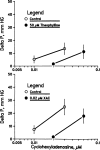Further characterization of the renovascular effects of N6-cyclohexyladenosine in the isolated perfused rat kidney
- PMID: 3559983
- PMCID: PMC5545103
Further characterization of the renovascular effects of N6-cyclohexyladenosine in the isolated perfused rat kidney
Abstract
Previous studies have shown that activation of A1 adenosine receptors results in renal vasoconstriction at submicromolar concentrations of N6-cyclohexyladenosine (CHA) followed by relative vasodilation at higher concentrations. The present data confirm these findings and demonstrate that Na loading enhances the vasoconstrictor effects of CHA in the isolated rat kidney perfused at constant flow. Furthermore, adenosine receptor antagonism with both theophylline and the A1-selective antagonist, xanthine amine congener (8-[4-[(2-aminoethyl)-aminocarbonylmethyloxy]phenyl]-1, 3-dipropylxanthine), produced a rightward and apparently parallel shift in the dose response to CHA. Determination of the inhibitory constants for both antagonists revealed that xanthine amine congener was three orders of magnitude more potent than theophylline in antagonizing CHA-induced renal vasoconstriction. Other investigators have hypothesized that angiotensin II mediates adenosine-induced renal vasoconstriction. However, we have been able to show that A1 receptor activation can result in renal vasoconstriction in the isolated perfused rat kidney devoid of renin substrate. Moreover, a competitive inhibitor of angiotensin II (saralasin) failed to attenuate the hemodynamic effects of CHA at doses that completely blocked the effects of angiotensin II itself. Taken together, these data are consistent with the hypothesis that A1 receptor activation in the kidney leads to vasoconstriction, a response that is enhanced by Na loading, and that A1 adenosine receptors and angiotensin II receptors are separate and distinct biochemical entities. Independent activation of either receptor leads to renal vasoconstriction, which can be prevented by its respective antagonist.
Figures




Similar articles
-
Contrasting effects of changes in salt balance on the renovascular response to A1-adenosine receptor stimulation in vivo and in vitro in the rat.J Pharmacol Exp Ther. 1991 Feb;256(2):542-6. J Pharmacol Exp Ther. 1991. PMID: 1825227
-
XAC, a functionalized congener of 1,3-dialkylxanthine, antagonizes A1 adenosine receptor-mediated inhibition of renin secretion in vitro.Arch Int Pharmacodyn Ther. 1987 Dec;290(2):293-301. Arch Int Pharmacodyn Ther. 1987. PMID: 3328570 Free PMC article.
-
Synergistic effects of angiotensin and adenosine in the renal microvasculature.Am J Physiol. 1994 Feb;266(2 Pt 2):F227-39. doi: 10.1152/ajprenal.1994.266.2.F227. Am J Physiol. 1994. PMID: 8141324
-
Mechanism of adenosine receptor-induced renal vasoconstriction in rats.Am J Physiol. 1988 Oct;255(4 Pt 2):H885-90. doi: 10.1152/ajpheart.1988.255.4.H885. Am J Physiol. 1988. PMID: 2459975
-
Methylxanthines and the kidney.Handb Exp Pharmacol. 2011;(200):391-412. doi: 10.1007/978-3-642-13443-2_15. Handb Exp Pharmacol. 2011. PMID: 20859805 Free PMC article. Review.
Cited by
-
Effects of pH on responses to adenosine, CGS 21680, carbachol and nitroprusside in the isolated perfused superior mesenteric arterial bed of the rat.Br J Pharmacol. 1995 Nov;116(6):2641-6. doi: 10.1111/j.1476-5381.1995.tb17220.x. Br J Pharmacol. 1995. PMID: 8590983 Free PMC article.
-
Adenosine receptor prodrugs: towards kidney-selective dialkylxanthines.J Pharmacol Exp Ther. 1989 Jul;250(1):79-85. J Pharmacol Exp Ther. 1989. PMID: 2746513 Free PMC article.
-
Tetrahydrobenzothiophenone derivatives as a novel class of adenosine receptor antagonists.J Med Chem. 1996 Jan 19;39(2):398-406. doi: 10.1021/jm9504823. J Med Chem. 1996. PMID: 8558508 Free PMC article.
-
Adenosine constricts the isolated and perfused monkey coronary artery.Heart Vessels. 1990;5(2):71-5. doi: 10.1007/BF02058320. Heart Vessels. 1990. PMID: 2354990
-
Vascular actions of purines in the foetal circulation of the human placenta.Br J Pharmacol. 1993 Sep;110(1):454-60. doi: 10.1111/j.1476-5381.1993.tb13832.x. Br J Pharmacol. 1993. PMID: 8220907 Free PMC article.
References
-
- Arend LJ, Haramati A, Thompson CJ, Spielman WS. Adenosine-induced decrease in renin release: Dissociation from hemodynamic effects. Am. J. Physiol. 1984;247:F447–F452. - PubMed
-
- Arend LJ, Thompson CI, Spielman WS. Dipyridamole decreases glomerular filtration in the sodium-depleted dog. Evidence for mediation by intrarenal adenosine. Circ. Res. 1985;56:242–251. - PubMed
-
- Berecek KH, Murray RD, Gross F. Significance of sympathetic innervation and central adrenergic structures on renal responsiveness in DOCA-treated rats. Circ. Res. 1980;47:675–683. - PubMed
-
- Berecek KH, Murray RD, Gross F, Brody J. Vasopressin and vascular reactivity in the development of DOCA hypertension in rats with hereditary diabetes insipidus. Hypertension. 1982;4:3–12. - PubMed
-
- Buckle PJ, Spence I. The actions of adenosine and some analogues on evoked and potassium stimulated release at skeletal and autonomic neuromuscular junctions. Naunyn-Schmiedeberg’s Arch. Pharmacol. 1982;319:130–135. - PubMed
Publication types
MeSH terms
Substances
Grants and funding
LinkOut - more resources
Full Text Sources
